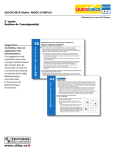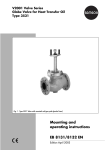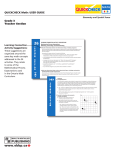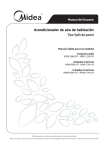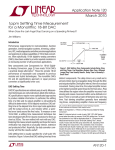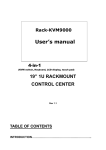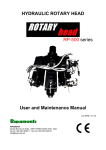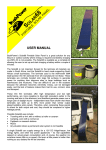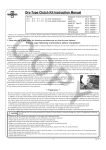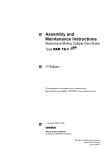Download ,3 ww 4,5, 33
Transcript
United States Patent [191 [111 4,210,034 Younger [45] Jul. 1, 1980 [54] msMi'sgggg FOR AUTOMATIC [76] Inventor: OTHER PUBLICATIONS Gilbert W. Younger, 2621 Merced Ave., El Monte, Calif. 91733 [21] Appl.No.: 824,331 [51] [52] Int.Cl.1 us. Cl. .. . F16H 51/02 74/606 R; 60/458; . 137/884 8 [5 1 F‘ l Transmission-Section 21-Figures 53-58. Chrysler-Chassis Body Manual-1978, Torqueflight Transmission, pp. 21-74, to 21-77. Aug. 15, 1977 [22] Filed: Chrysler, Chassis Service Manual-1972-Torqueflight fSearch 74 606 R; 137 884; wdo / 6O//458 Primary Examiner-Samuel Scott Assistant Examiner-Wesley S. Ratliff, Jr. Attorney, Agent, or Firm-Ralph B. Pastoriza ABSTRACT [57] , _ . . A channel plate is, provided for blocking transmission oil ?ow between two shift valves normally provided to [56] References Cited effect automatic sequential shifting with changes in the U.S. PATENT DOCUMENTS pressure of the transmission oil. By inserting the chan nel plate, the gears in the transmission can only be .1ma“ k. 3 4,5,ww,3m48 29AA 9 mm TKPurcell 3,548,849 l2/l970 3,840,047 10/1974 Gibbins shifted manually. 2 Claims, 3 Drawing Figures US. Patent Jul. 1, 1980 4,210,034 1 4,210,034 2 To eliminate the automatic shifting of a transmission so that the above referred to manual shifting can be CHANNEL PLATE FOR AUTOMATIC TRANSMISSIONS effected normally would require a disassembly of the entire transmission system. Such a conversion operation This invention relates generally to automatic trans 5 is not only expensive and time consuming but in the event it is desired to convert the system back into auto missions for automobile engines and more particularly matic transmission shifting control, the same disassem to a channel plate structure to convert the automatic bly operation would be required. shifting to manual shifting. BACKGROUND OF THE INVENTION 1O Most automatic transmissions for shifting gears in automobile engines comprise various sun and planetary gears with appropriate clutch plates and bands respon sive to hydraulic oil pressure to hold one or more gears and thus change the effective ratio between input shaft speed from the engine and output shaft speed to the wheels. The heart of such transmission systems is a valve body containing various inter-related passages, valves, springs and ori?ces. The valve body receives signals in the form of hydraulic pressures which func tion to shift various ones of the shift valves to thereby route the transmission oil to appropriate clutch plates or BRIEF DESCRIPTION OF THE PRESENT INVENTION With the foregoing considerations in mind, the pres ent invention contemplates a simple and uniquely di mensioned channel plate arranged to be inserted be tween a normally provided valve cover and the en trance to bores containing shift levers normally pro vided in the valve body of the automatic transmission system. Essentially, the channel plate blocks transmis sion oil flow between the two shift valves in the adja cent bores which transmission oil ?ow is normally pro vided to effect automatic sequential shifting with bands and thus automatically effect sequential shifting changes in the pressure of the transmission oil. As a consequence, the gears in the transmission can only be within a given range. Mechanical shifting is effected by shifted manually once the channel plate is in position. mechanical movement of other valves to change from a 25 given shift range to another given shift range, this shift ing normally being accomplished by the shift lever. For most normal driving, there is only one position for the manual shift lever which is the drive or D posi tion. Once the lever is placed in this position, the shift ing of the gears is completely automatic. The same shift lever also serves to shift certain other valves to effect reverse movement of the automobile. In effecting movement of the various shift valves to properly route the oil to appropriate clutch plates, the controlled hydraulic transmission oil pressure is used as described. This pressure is made responsive to the shaft speed as well as the shaft torque. The drive shaft speed BRIEF DESCRIPTION OF THE DRAWINGS A better understanding of this invention will be had by referring to the accompanying drawings in which: FIG. 1 is a perspective cut-away view of a typical automatic transmission system for an automobile, cer tain parts being depicted purely schematically for ease in explanation; FIG. 2 is an enlarged exploded fragmentary perspec tive view of a portion of the valve body of the transmis sion system of FIG. 1 looking generally in the direction of the arrow 2; and, FIG. 3 is an end elevation of the assembled compo~ nents shown in FIG. 2 wherein phantom lines are pro vided to depict the desired result. is measured by a governor and this information is re layed to the valve body in the form of more or less 40 hydraulic pressure by opening a speci?c valve a precise amount. Thus, with the manual shift lever in the drive or “D” position, the automobile can be started from a rest posi tion, the various gears automatically shifting from low through intermediate positions to high. While such shifting is completely automatic, the driver does have some control in that the manual shift lever usually in cludes 1 and 2 positions constituting low gear ratios as might be used when climbing a steep grade or as a brak ing feature when descending a steep grade. As men tioned, however, once the manual gear shift lever is set in one of its various positions, automatic shifting occurs within the given shift range of that position. DETAILED DESCRIPTION OF THE INVENTION Referring first to FIG. 1, the automatic transmission is designated generally by the numeral 10 having an input shaft 11 from the automobile engine coupled by means of various planetary and sun type gears 12 pro vided with appropriate clutch plates and bands sche matically indicated at 13 to an output shaft 14 connect ing to the driving wheels of the vehicle. As described heretofore, the ratio of the input to output shaft speeds for the shafts 11 and 14 is controlled by the various gears within the transmission body 10 by means of the clutch plates and clutch bands which, when actuated, will “clutch” certain gears to prevent their rotation There are many instances, however, when a driver thereby effecting the desired change in speed ratio. The may wish to effect all shifting manually rather than have the shifting take place automatically. In the case of manual shifting, the driver would always start the vehi cle in the number 1 or number 2 gear shift lever position operation of the clutch plates and clutch bands is ef fected by hydraulic oil pressure routed to the appropri ate plates and bands in accordance with the shaft speed and torque. and progress up to the drive or “D” position. In the Thus, there is provided from appropriate transmis sion oil pump 15 transmission oil having a varying hy~ draulic pressure depending upon the shaft speed, torque would not automatically shift down or up with varying etc. This transmission oil, as indicated schematically by shaft speed and/or torque. Such manual shifting pro the solid line 16 is passed to the transmission valve body vides the driver with a maximum degree of control over the gears. Such might be desirable in certain racing car 65 17 constituting the heart of the transmission system. The valve body 17 includes various inter-related passages, operations or in certain driving situations wherein it shift valves, springs and the like for routing the oil in the might be desirable to have the car remain in “low” oil sump or pan 18 constituting an oil reservoir to the regardless of its speed or torque requirements. “D” position, the gears would always be in “high” and 4,210,034 various clutch plates and bands, the passage of the oil from the valve body again being schematically depicted by the solid lines 19. In accord with the present invention, to convert auto matic shifting to manual shifting requires modi?cation of only a certain portion of the valve body 17 as op posed to having to disassemble the entire transmission 4 the channel plate itself in turn places the second bore 22 into communication with the transmission oil port 25. This transmission oil pressure is received also in the passage 27 by way of the elongated opening 30 but since the other end of the passage 27 is completely eclipsed or sealed by the channel plate, there will be no communi cation of this transmission oil with the ?rst bore 21. to effect such modification. This portion of the valve Since the ?rst shift valve 23 in the ?rst bore 21 is no body 17 to be modi?ed includes ?rst and second shift valves involved in the automatic shifting from “low” to longer subject to the governed transmission oil pressure if the manual shift lever is placed in its “low” position, “high” and its location is designated generally by the the transmission gears will always be in “low” regard arrow 20 in FIG. 1. less of the speed or torque of the transmission shaft. Shifting to a higher gear can then only be accomplished Referring to FIG. 2, details of the valve body 17 as shown by the arrow 20 will be described. Thus, the normal valve body 17 includes in its side ?rst and sec ond bores 21 and 22 for receiving ?rst and second shift valves portions of which are shown at 23 and 24 within the bores. It will be understood that there are springs associated with these valves such that the degree of hydraulic pressure exerted thereon to effect a move ment or shifting can be appropriately adjusted. In addi 20 tion, the diameter of the bores themselves receiving the shift valves are appropriately adjusted to adjust the area of the valve exposed to hydraulic pressure applied to the bores which again will determine the amount of by manual shifting of the shift lever. Should it be desired to reconvert the transmission system back to automatic shifting, it is a simple matter simply to remove the channel plate 28 and remount the valve cover 26 so that the bores 21 and 22 are again then placed in communication by way of the passage 27. From the foregoing description, it will thus be evi dent that the present invention in the form of the chan nel plate 28 enables automatic shifting to be converted to manual shifting in an automatic transmission system without the necessity of disassemblying the entire trans mission. hydraulic pressure necessary to move any speci?c shift I claim: 25 valve. 1. In an automatic transmission for shifting gears, a The bores 21 and 22 with their corresponding shift channel plate for blocking transmission oil flow be valves 23 and 24 are normally both provided with trans tween two shift valves normally provided to effect mission oil pressure controlled by the transmission gov automatic sequential shifting with changes in the pres ernor as by way of a small port 25 and a valve cover sure of said transmission oil so that the gears in said plate 26 with a passage 27 therein placing the bores 21 30 transmission can only be shifted manually, said two shift and 22 into communication with the port 25. Thus, for valves being receivable in side-by-side valve bores in automatic shifting, the cover plate 26 when placed di the valve body for said automatic transmission, said rectly over the bores 21 and 22 will result in the trans bores normally being covered by a valve cover having mission oil being applied to both of the shift valves 23 and 24 by way of the passage 27. Because of the differ 35 an internal passage placing said bores in communication with each other and with the transmission oil, said chan ence in the bore diameters, and the spring loading of the nel plate comprising a thin metal member insertable valves, sequential shifting of the valves will occur as the transmission oil pressure is increased. To remove the automatic shifting feature so that the gears can be shifted only manually in accord with the present invention, there is provided a channel plate 28 for insertion between the valve cover plate 26 and en trances to the bores 21 and 22 to eclipse the passage 27 in the cover plate so that the oil ?ow through the pas sage is blocked. Under these conditions, automatic shift ing of the valves with increasing hydraulic transmission oil pressure is prevented. As is evident from FIG. 2, the channel plate 28 is in between said valve cover and entrances to said bores to eclipse said passage so that oil flow through said pas sage is blocked, said metal member further including a side notch placing one of said bores in communication with the exterior of said valve body and an elongated opening placing the other of said bores in communica tion with said transmission oil. 2. In an automatic transmission for shifting gears in an automobile engine wherein there are provided ?rst and second bores in the valve body of said transmission for receiving ?rst and second shift valves and wherein a valve cover plate having a passage therein is dimen sioned to overlie said bores with said passage placing inserted simply by removing the cover plate 26 and sandwiching the channel plate 28 in position. 50 said bores in communication with each other so that transmission oil pressure controlled by the transmission It will be noted that the channel plate 28, in addition the form of a thin metal member which can be readily to sealing off the passage 27 from the bores, further governor is applied from an opening adjacent to said includes a side notch 29 arranged to register with the ?rst bore 21 to exhaust oil therefrom to the exterior; that is, to the oil sump or oil pan 18 of FIG. 1. Also provided is an elongated opening 30 having one end positioned to register with the second bore 22 and its other end to register with the transmission oil inlet opening 25 so that the second bore is subject to gov erned transmission oil pressure. second bore to both valves to effect a desired sequential Referring to FIG. 3, the relative positions of the passage 27, bores 21 and 22, notch 29 and elongated opening 30 of the channel plate are depicted by phan tom lines after the components have been assembled. Thus, it will be noted that with the channel plate 28 in position, the passage 27 in the valve cover 26 is sealed 65 off from communication with the ?rst bore 21, the oil in this bore being exposed or exhausted to the exterior by means of the side notch 29. The elongated opening 30 in shifting, a channel plate for insertion between said valve cover plate and said bores, (a) said channel plate being dimensioned to seal off said passage from said bores to block communica tion between said bores, and further including (b) a side notch registering with said first bore to exhaust oil therefrom, and (c) an elongated opening having one end positioned to register with said second bore and its other end to register with said transmission oil opening so that the ?rst bore is exhausted and the second bore subject to governed transmission oil pressure thereby preventing automatic sequential shifting so that the transmission gears can only be shifted man ually. '




